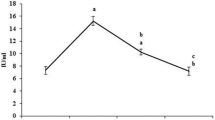Abstract
To examine the relationship between the decrease in connexin 32 (Cx32) and induction of P450 isozymes in the early phase of clofibrate hepatocarcinogenesis, a total of 20 male F344 rats were initiated with a single intraperitoneal injection of 150 mg/kg of diethylnitrosamine (DEN) or given the saline vehicle alone and starting 2 weeks later given diet containing 0.18, 0.09, and 0% clofibrate for 6 weeks. All animals were subjected to two-thirds partial hepatectomy at week 3 and killed at week 8. Absolute and relative (ratios to body weight) liver weights were significantly increased in the DEN + clofibrate groups compared with the DEN-alone group. Diffuse hepatocellular hypertrophy with granular cytoplasmic eosinophilia characterized by a marked increase in peroxisomes and smooth endoplasmic reticulum, was observed in the clofibrate treated rats. Induction of cytochrome P450 (CYP) 4A1 and 2B1/2 was noted in the DEN + clofibrate groups, this being most marked in the CYP 2B1 case. Immunohistochemically, positive immunostaining for anti-CYP 4A1 and CYP 2B1 were observed diffusely and centrilobularly, respectively. The numbers and areas of Cx32-positive spots per hepatocyte in the centrilobular areas in the treated rats were significantly decreased in an essentially dose-dependent manner, but no changes were observed in periportal areas. The numbers and areas of foci positive for glutathione S-transferase placental form (GST-P) were decreased in a dose dependent manner in the clofibrate treated groups. These results suggest that the CYP 2B1/2 induction and Cx32 decrease in centrilobular hepatocytes, similarly to those thought to be involved in the hepatic promotion mechanism of phenobarbital, may also play important roles in clofibrate actions in the liver, in addition to its causation of oxidative DNA injury.
Similar content being viewed by others
Author information
Authors and Affiliations
Additional information
Received: 30 March 1999 / Accepted: 8 June 1999
Rights and permissions
About this article
Cite this article
Shoda, T., Mitsumori, K., Onodera, H. et al. The relationship between decrease in Cx32 and induction of P450 isozymes in the early phase of clofibrate hepatocarcinogenesis in the rat. Arch Toxicol 73, 373–380 (1999). https://doi.org/10.1007/s002040050676
Issue Date:
DOI: https://doi.org/10.1007/s002040050676




